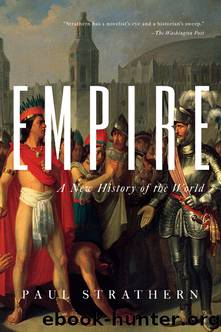Empire by Paul Strathern

Author:Paul Strathern
Language: eng
Format: epub
Tags: Epub3
Publisher: Pegasus Books
Sequence
Concurrent with the Aztec Empire was the Inca Empire, which at its height occupied the remote east coast and hinterland of South America from the southmost tip of Colombia as far as mid-Chile, a distance of some 2,500 miles. In isolation, this too had developed into an original civilisation, quite independently of the Aztecs. The Inca’s wealth, and their downfall, resulted largely from Potosi, the so-called ‘mountain of silver’, which soon attracted the attention of the Spanish conquistador, Francisco Pizzaro, who led just 160 men and conquered the empire in two years. However, he never discovered the empire’s masterpiece, the so-called ‘lost city of the Incas’. This was Machu Picchu, built over 8,000 feet up in the Peruvian Andes, by a civilisation that had only llamas (worthless as pack animals over mountainous terrain), and like the Aztecs had yet to discover the wheel. Machu Picchu would remain ‘lost’ for another 400 years.
However, in 1553 the Spanish did discover an ancient artefact, which remains as impressive and perplexing as any yet found on earth. Some 1,700 feet up in the Peruvian Andes they came across a long, permanently dry, windless, arid plateau covered in drawings known as the Nazca Lines. These depict in outline vast geoglyphs – drawings of plants, animals, even spiders, and primitive representations of human-like creatures with round heads, eyes and legs. And a number of seemingly unknown creatures. As well as these there are a series of undeviating straight lines, some over 1,000 feet long, which have been drawn across the desert floor.
It appears that these all date from around 200 and 600 BC. Yet despite all manner of ingenious explanations, no serious investigator has yet managed to provide any entirely convincing explanation of their existence. By contrast, the irrepressible Erich von Däniken has asserted that these markings were created by ‘ancient astronauts’. Despite such tomfoolery, there is no denying that the full beauty and art of these markings can only fully be appreciated when they are viewed from high in the sky, and are even visible from satellites.
Such pre-modern imperial wonders appear all the more amazing when seen in the larger historical context of the migration of Homo sapiens to the very limits of the habitable globe. The challenges encountered on these migrations had led to Homo sapiens mastering a series of entirely new cognitive skills. As we have seen, the manifestations of these developments bore both perplexing similarities and astonishing differences. Yet in a profound sense, they were common throughout the species. They involved traits capable of abstract, symbolic and religious behaviour. This was the beginnings of art, science and writing. Humanity as we know it had been born.
But this new variant species was far from being any Nietzschean ‘superman’ in comparison with his fellow hominids. Homo sapiens may have been taller than Homo erectus and others, but many of these – especially Neanderthals – were much stockier and physically stronger. Threats from early hominids, climate change, geography and all the ‘accidents of history’ ensured
Download
This site does not store any files on its server. We only index and link to content provided by other sites. Please contact the content providers to delete copyright contents if any and email us, we'll remove relevant links or contents immediately.
| Africa | Americas |
| Arctic & Antarctica | Asia |
| Australia & Oceania | Europe |
| Middle East | Russia |
| United States | World |
| Ancient Civilizations | Military |
| Historical Study & Educational Resources |
The Daily Stoic by Holiday Ryan & Hanselman Stephen(3264)
The Fate of Rome: Climate, Disease, and the End of an Empire (The Princeton History of the Ancient World) by Kyle Harper(3030)
People of the Earth: An Introduction to World Prehistory by Dr. Brian Fagan & Nadia Durrani(2711)
Ancient Worlds by Michael Scott(2648)
Babylon's Ark by Lawrence Anthony(2648)
The Daily Stoic by Ryan Holiday & Stephen Hanselman(2522)
Foreign Devils on the Silk Road: The Search for the Lost Treasures of Central Asia by Peter Hopkirk(2442)
India's Ancient Past by R.S. Sharma(2432)
MOSES THE EGYPTIAN by Jan Assmann(2393)
The Complete Dead Sea Scrolls in English (7th Edition) (Penguin Classics) by Geza Vermes(2258)
Lost Technologies of Ancient Egypt by Christopher Dunn(2207)
The Earth Chronicles Handbook by Zecharia Sitchin(2203)
24 Hours in Ancient Rome by Philip Matyszak(2065)
Alexander the Great by Philip Freeman(2044)
Aztec by Gary Jennings(1992)
The Nine Waves of Creation by Carl Johan Calleman(1897)
Curse Tablets and Binding Spells from the Ancient World by Gager John G.;(1851)
Before Atlantis by Frank Joseph(1832)
Earthmare: The Lost Book of Wars by Cergat(1806)
